Bird's-Nest Fern Care Guide


Uncover the essential tips for nurturing your bird's nest fern (Asplenium nidus), a tropical epiphyte celebrated for its striking, nest-like fronds. This guide will reveal how to provide the perfect care for your fern, including ideal watering practices, the best substrates, and effective methods for propagation.
In the following article from TheDailyECO, you’ll find a comprehensive Bird's Nest Fern care guide designed to help your plant flourish.
Characteristics of Bird's Nest Ferns
The bird's nest fern, scientifically known as Asplenium nidus, is a tropical epiphyte, meaning it grows on other plants, typically trees. The bird's nest fern has elongated, wavy leaves that are glossy and light green.
Each leaf can measure up to 50 centimeters (about 20 inches) in length and has a smooth texture. They all originate from a central point called a rosette and are arranged in a circular pattern, resembling a nest. This arrangement gives the fern its common name, "bird's nest fern."
Native to tropical rainforests of Southeast Asia, Australia, and the Pacific Islands, the bird's nest fern thrives in humid, shaded environments. It often grows on tree trunks or branches, using its roots to anchor itself and absorb nutrients from the air and rainwater.
Light, Temperature, and Placement for Bird's Nest Ferns
While the bird's nest fern (Asplenium nidus) can tolerate low-light conditions, it thrives in bright, indirect light. Think of its natural habitat in tropical rainforests: shaded, yet illuminated by filtered sunlight. While it can survive in areas with little natural light, even with artificial lighting, its growth and vitality will be limited. For optimal growth, aim to provide it with conditions similar to its tropical origins.
If you live in a tropical climate, you can grow the bird's nest fern outdoors in a shaded spot. For those in temperate or colder climates, indoor cultivation is ideal. Place it near a window that receives bright, indirect light.
Avoid direct sunlight, which can scorch the fronds. A bathroom, solarium, or glass vivarium can also provide suitable conditions, especially if humidity is high.
As a tropical plant, the bird's nest fern prefers warm temperatures. Maintain a range of 15-25°C (59-77°F) for optimal growth and development. Avoid extreme temperatures, both hot and cold, as they can stress the plant.

Substrate and Compost for Bird's Nest Ferns
The substrate for Bird's Nest Ferns should be light and well-draining, enriched with a mix of organic matter. A combination of perlite or vermiculite, heather, peat, and sand works well to create an ideal growing medium.
Since this fern grows very slowly, it does not require frequent fertilization. A small amount of general-purpose liquid fertilizer or a fertilizer designed for green plants can be applied to the soil as needed. Avoid fresh compost because it can contain harmful pathogens that can damage the roots. However, well-rotted compost can be added to the substrate to improve its organic matter content.
Unlike some plants, the Bird's Nest Fern benefits from periodic repotting. It is essential to repot the fern every one to two years, providing fresh soil and a new pot to support its continued growth and development.
Watering for Bird's Nest Ferns
For many plants, especially ferns, there's a common misconception that more water equates to better growth. This is not the case. While it's important to provide enough water to support root development and overall growth, excessive watering can be detrimental.
In summer, you should water more frequently and abundantly, while in winter, reduce both the amount and frequency of watering. To determine when it's time to water, insert your finger about two centimeters into the soil or use a moisture meter. If the soil feels dry, it's time to water. Be cautious, as ferns do not tolerate waterlogged soil well.
If you live in an area with inconsistent humidity, you can create a more suitable environment for your fern. Regularly misting the leaves and the top layer of soil can help maintain the necessary moisture levels. Additionally, placing the plant near a window can help retain ambient humidity, benefiting the fern's overall health.

Pruning for Bird's Nest Ferns
This fern does not need specific pruning to enhance its growth or control its size. Simply remove any wilted, brown, yellow, dry, or diseased leaves as needed.
Ever wondered about the secrets behind a fern's ability to grow and thrive? Learn more about its reproductive process in our next read.
Reproduction for Bird's Nest Ferns
Bird's nest ferns reproduce through spores, tiny reproductive structures found on the underside of their fronds. These spores are similar to the seeds of flowering plants. To do it, follow these steps:
- Carefully remove a frond with mature spores.
- Place the frond in a paper bag and allow the spores to fall naturally.
- Fill a small pot with a well-draining substrate like peat moss and perlite. Sterilize the substrate to prevent contamination.
- Sprinkle the spores evenly over the surface of the substrate. Do not cover them.
- Cover the pot with a plastic bag to create a humid atmosphere. Place the pot in a warm, shaded location.
- Mist the substrate regularly to keep it moist but not soggy.
It may take several weeks or even months for spores to germinate.
Eager to grow more lush and vibrant ferns? Explore how to care for and propagate another popular variety in our related article.

Preventing and Treating Common Ailments for Bird's Nest Ferns
To ensure the health and vitality of your bird's nest fern, it's essential to proactively address potential diseases and pests.
Fungal diseases
Fungal diseases can manifest in a bird's nest fern through symptoms such as brown spots, yellowing leaves, or a general decline in plant health.
To prevent these issues, it's crucial to avoid overwatering and ensure that the pot has proper drainage. Regularly removing dead or decaying plant material will also help minimize the risk of fungal growth.
Root rot
Root rot, another common issue, is often indicated by yellowing leaves, wilting, and a foul odor emanating from the base of the plant.
To prevent root rot, allow the substrate to dry out slightly between waterings and make sure the pot has adequate drainage to prevent waterlogging. By addressing these factors, you can help maintain a healthy environment for your bird's nest fern.
Common pests
Mealybugs and mites are common tiny pests can cause yellowing leaves, stunted growth, and a general decline in plant health. To control it, manually remove visible pests with a damp cotton swab or use a diluted insecticidal soap or neem oil solution. Increasing humidity can also help deter these pests.
Early detection and intervention are key to effectively managing diseases and pests in your bird's nest fern. Regularly inspect your plant for signs of trouble, and take prompt action if you notice any issues.
Wondering why your plant’s leaves are showing unusual spots? Discover what those black marks might signify in our related article.
If you want to read similar articles to Bird's-Nest Fern Care Guide, we recommend you visit our Plant care and cultivation category.
- Koh, H.L., Chua, T.K., Tan, C.H. (2009). A Guide to Medicinal Plants: An Illustrated, Scientific and Medicinal Approach. Singapore: World Scientific Pub.
- Hubbard, D. H. (2023). Ferns of Hawaii National Park. Czechia: Good Press.








